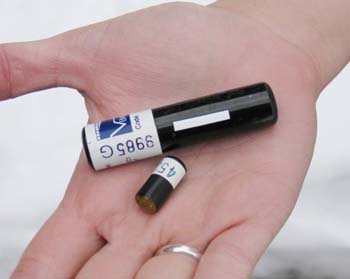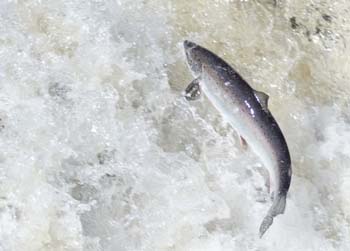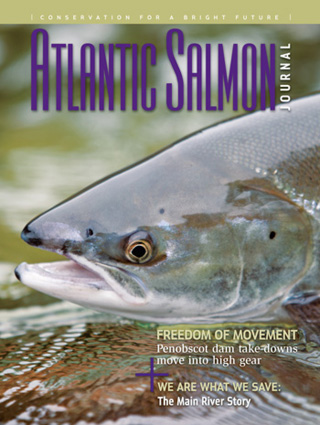ASF urges caution for 2017 ahead of international salmon talks. New State of the Populations report shows potential for low Atlantic salmon returns this year
Atlantic Salmon Federation / Saint Andrews, New Brunswick / June 1, 2017
[dropcap]F[/dropcap]inal population estimates for North American Atlantic salmon show returns in 2016 were lower than the year before and may indicate further declines in 2017. As a result, ASF is urging anglers and indigenous groups to exercise caution by practicing live release or allowing more fish to pass upriver.
This conclusion is based on data from Canada, Quebec, the United States, and Greenland and comes just ahead of next week’s meeting of the North Atlantic Salmon Conservation Organization (NASCO) in Varberg, Sweden where national government delegates will discuss the measures to protect the species.
ASF’s State of the Populations report found total estimated North American returns for 2016, including large salmon and grilse, was 533,500 individuals, a 27 per cent decrease from 2015
Grilse, which is Atlantic salmon that return to spawn after only one year at sea, saw the greatest decrease, 31 percent lower than 2015. This situation triggered a special meeting in Newfoundland and Labrador and was a factor in the decision to continue mandatory live release for anglers in New Brunswick and Nova Scotia.
NOTE: One metric ton or tonne equals 2204.62 pounds.
Similarly, Greenland reported a significant decline in the number of Atlantic salmon taken last year. The government of Greenland reported a harvest of 27 tonnes (8,400 salmon) in 2016 compared to 57 tonnes (17,700 salmon) in 2015. The quota in 2016 was set at 32 tonnes because the 2015 catch exceeded Greenland’s 45 tonne quota. The quota for 2017 will once again be 45 tonnes.
The drop in 2016 grilse returns combined with low numbers at Greenland may have implications for the return of large, two sea-winter salmon on 2017.
“Last year’s grilse and this year’s two sea-winter fish went to sea at the same time,” said ASF President Bill Taylor. “With grilse returns down sharply and quota left unfilled in Greenland, it suggests this year class has struggled to survive.”

ASF Researcher Jonathan Carr reads data received by a VR2 Sonic receiver. (photo Tom Moffatt/ASF)
The International Council for the Exploration of the Seas (ICES) has reviewed the same data and is warning against any mixed stock fishery or in-river harvest of large salmon where conservation limits are not being reached. ICES is a network of more than 5,000 scientists that provides unbiased fisheries advice to 20 member countries including Canada.
“We hope we’re wrong about large salmon returns this year, but in light of this information anglers, people in St. Pierre and Miquelon, and indigenous groups should take steps to maximize salmon survival this year,” said Taylor.
Overall, anglers and indigenous groups in Canada harvested 135 tonnes of Atlantic salmon in 2016, equal to approximately 46,000 grilse and 12,000 large salmon

The Larger sonic transmitter is for insertion in kelts; the smaller is for smolt. (ASF Photo)
Recreational anglers killed 69 tonnes (36,355 grilse and 1,823 large salmon), while aboriginal groups harvested an estimated 64-tonnes (approximately 10,000 grilse and 9,600 large salmon). Some recreational and aboriginal harvest takes place on rivers that are not meeting conservation requirements.
In the United States, numbers remain critically low. A total of 636 Atlantic salmon were counted in all American rivers last year, equal to only three per cent of the spawning fish required to meet conservation limits. Atlantic salmon are protected by the U.S. Endangered Species Act, and angling is completely closed.
Rivers in Eastern Cape Breton, the Atlantic coast of Nova Scotia, and the Bay of Fundy fared better on average than the United States, but extirpation remains a possibility if aggressive conservation and recovery actions are not taken to reverse the decline
Because Atlantic salmon from most North American rivers migrate to the same areas, mixed stock fisheries that target salmon on their ocean feeding grounds at Greenland and the Faroe Islands, and fisheries that intercept returning salmon at St- Pierre et Miquelon and Labrador, can have a disproportionate effect on depressed populations.
ASF’s Icelandic partner, the North Atlantic Salmon Fund (NASF), has secured a long-term conservation agreement with Faroese fishermen that suspends their harvest of Atlantic salmon. ASF and NASF continue to seek a similar deal with Greenland fishermen, renewing an agreement that was in place between 1992-1993 and 2002-2011 which reduced the harvest of Atlantic salmon to low, subsistence levels. In return for catching fewer salmon, ASF and NASF use private funds to compensate fishermen fairly and support alternative economic activities.

Atlantic salmon leaping in northern Newfoundland (photo Tom Moffatt/ASF)
These conservation agreements have saved tens of thousands of large salmon and had a direct effect on populations in North American rivers
“Every person who angles harvests salmon spends time on a river, or just values nature has a role to play in Atlantic salmon conservation. Governments must do more to limit the number of Atlantic salmon that are killed every year, and we hope the officials at next week’s NASCO meetings in Sweden make this a priority,” said Bill Taylor.
To See Backgrounder for detailed information on the status of all North American Atlantic salmon populations, click here . . .
NOTE: Featured Image is April Vokey with an Atlantic Salmon caught while fly fishing in Iceland. Image by Fishing Iceland.
[information]
For more information contact:
Neville Crabbe – ASF Communications
ncrabbe@asf.ca
(506) 529-1033
The Atlantic Salmon Federation was founded in 1948 with the goal of conserving and restoring wild Atlantic salmon stocks throughout the North Atlantic. Our federation includes provincial and state councils, and affiliate groups throughout Eastern Canada and New England, representing thousands of members and volunteers.
[/information]



